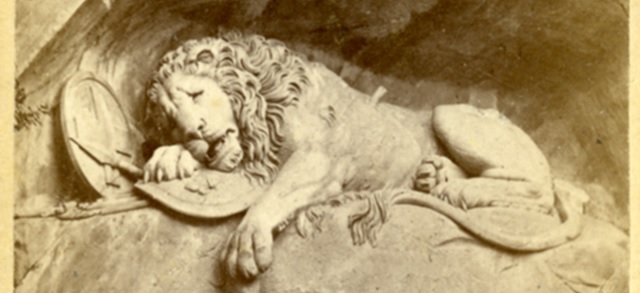
Monuments Class Projects
Architect/Sculptor of Monument
Henry Weekes (1807-1877)
Preview

Identifier
12a
Medium
photograph, carte-de-viste
Keywords
Percy Shelley Monument, Christchurch Priory, Mary Shelley, Percy Shelley, Henry Weekes, Percy Florence Shelley, romanticism, neoclassical statue
Name of Monument
Percy Shelley Monument
Date of Completion or Dedication of Monument
1854
City of Monument
Christchurch
Location within City
Christchurch Priory
State/Province of Monument
Dorset
Country of Monument
England
Description
A photograph of the Percy Shelley Monument, a Neoclassical sculpture, in Christchurch, England. The statue was commissioned by Shelley’s surviving son, Percy Florence Shelley, and was carved by Henry Weekes in the early 1850’s. The sculpture depicts Shelley, who drowned off the coast of Italy in 1822, being held by his wife, Mary Wollstonecroft Shelley, author of Frankenstein.
School of Art/Architecture
Neoclassical Sculpture
Publisher
Firth & Co.
Digital Date
1-19-2022
Copyright
Original physical carte-de-visite is in the public domain. Digital copy scanned by Rod Library, ©2022 Rod Library, University of Northern Iowa.
Rights Advisory
Original print carte-de-visite card is in the public domain; U.S. and International copyright laws protect this digital object. Commercial use of this digital object is not permitted without prior permission of the copyright holder.
Creative Commons License

This work is licensed under a Creative Commons Attribution-NonCommercial 4.0 International License
File Format
image/jpeg



Comments
Background
Percy Shelley and Henry Weekes: Poet and Sculptor
Percy Shelley
Percy Bysshe Shelley, 1792-1822, is regarded today as one of the most influential English poets of the Romantic era.[1] In life he was a somewhat controversial figure. He was expelled from Oxford for writing and distributing a pamphlet titled, “The Necessity of Atheism.”[2] After death his reputation fluctuated. In the nineteenth century he was highly revered, but in the early twentieth century his reputation took a sharp downward turn. This was largely due to the criticism of T.S. Eliot, who considered Shelley’s use of metaphor to be an “abuse of poetry.” By the end of the twentieth century, Shelley’s reputation had recovered as a result of several prominent literary critics taking a positive interest in his work.[3] Two of his most well known works are Queen Mab and Adonais.[4] He is also remembered as the husband of Mary Shelley, author of Frankenstein. Shelley drowned off the coast of Italy in the Gulf of Spezia when his boat overturned.[5] He is the subject of the monument in Christchurch.
Henry Weekes
Henry Weekes, 1802-1877, was an English sculptor who studied at England’s Royal Academy, he eventually served as the academy’s Professor of Sculpture from 1869 until his death. [6] His sculpting style fused classicism and realism and he is most well remembered for his funerary relief monuments and portraiture.[7] According to Mary Stocker, Weekes was, “the most successful establishment sculptor of the mid-Victorian period.” One of his most famous works is his bust of Queen Victoria, the first sculpted portrait of the queen after her ascension to the throne.[8] He is the designer and sculptor of the Percy Shelley Monument in Christchurch.
Percy Shelley Monument, Christchurch, England
Carved on the monument is the inscription,
“To the Memory of / Percy Bysshe Shelley / Born at Field Place in the County of Sussex, August 4th, 1792 ‘Drowned by the upsetting of his boat in the Gulf of Spezzia, July 1822 / His ashes are interred in the Protestant Burial Ground at Rome / Also to the Memory of / Mary Woolstonecraft Shelley, his wife / Her remains are interred, together with those of her father, William Goodwin / and her mother Mary Woolstonecraft Goodwin / in the churchyard at Bournemouth[9]
Underneath that is nine lines from Shelley’s poem, Adonais
The sculpture itself is largely neoclassical, but Weekes also includes the realistic style he was so known for. Instead of the typical heroic figure often found in neoclassical statues, the sculpture shows the body of Percy Shelley, drowned, cradled by his wife, Mary Shelley, in a clear allusion to Michaelangelo’s Pietá.[10] The statue was commissioned by the Shelley’s only surviving child, Percy Florence Shelley, and was originally going to be placed in the graveyard of St. Peter’s Church, Bournemouth, where Mary Shelley is buried alongside her husband’s heart (the rest of his body is interned in the Protestant Cemetery in Rome). St. Peter’s rejected the monument and instead Shelley placed it in Christchurch, which was nearby Boscombe, his home.[11]
[1]Percy Bysshe Shelley, and William Michael Rossetti, Adonais, (The Floating Press: 2010, Auckland).
[2] Shelley and Rossetti, Adonais, 13.
[3] Newton, K.M., “Shelley, Percy Bysshe 1792-1822,” in Encyclopedia of the Romantic Era, 1760-1850, edited by Christopher John Murray (Routledge: 2003).
[4] Shelley and Rossetti, Adonais, 14.
[5] Henry Weekes, Percy Shelley Monument, Christchurch, England, 1854, Christchurch, England.
[6] Mary Stocker, “Weekes, Henry,” in Oxford Art Online, Grove Art Online, (Oxford University Press: 2003).
[7] Mary Stocker, “Weekes, Henry.”
[8] Wilson, David, “The ‘unjustly forgotten’ Henry Weekes RA (1807-1877),” in The British Art Journal, vol. 20, no. 2, (British Art Journal: 2019), pp. 22-41.
[9] Henry Weekes, Percy Shelley Monument, Christchurch, England, 1854, Christchurch, England.
[10] Calé, Luisa and Stefano Evangelista, “‘A bright and erroneous dream’: The Shelley Memorial and the body of the poet,” in A Journal of Verbal/Visual Enquiry, vol. 34, (Word & Image: 2018), pp. 16-30.
[11] “Memorial to Percy Bysshe Shelley,” Memorial to Percy Bysshe Shelley / Art UK, https://artuk.org/discover/artworks/memorial-to-percy-bysshe-shelley-303859, DOA: April 21st, 2022.